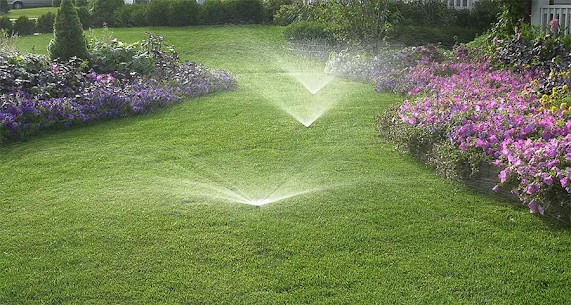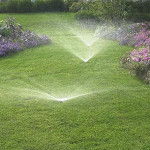Keeping a healthy lawn in Indianapolis isn’t always easy. Between summer heat, clay-heavy soil, and unpredictable rain, your grass might feel more like a crunchy carpet than a soft, green space. That’s why working with a reliable sprinkler installation company is key to getting the right irrigation system for your yard.
If you’re starting or need a better setup, this post is all about smart, simple sprinkler system solutions that make lawn care easier.
How to prepare your yard for sprinkler installation is also covered, ensuring that your space is ready for the best results. And the best part? You don’t have to figure it all out alone—Warweg & Co., Inc. is here to help with expert installation and irrigation services across Indiana.
What Kind of Irrigation System Should I Choose for My Backyard?
Sprinkler Systems: The Classic Choice
Spray sprinkler heads: Great for smaller spaces, they cover your lawn with a fine mist of water.
Rotary sprinkler heads: Better suited for larger areas, they shoot water in a circular pattern, similar to a spinning fan.
Pop-up sprinklers: These stay hidden underground until it’s time to water. Less mess, less tripping!
Drip Irrigation: Water Straight to the Roots
Drip lines: Plastic tubing with small holes lets water drip directly near the plants’ roots.
Good for tricky spaces: If your yard has shrubs, flower beds, or trees, drip systems can reach spots regular sprinklers miss.
Soaker Hoses: Simple and Budget-Friendly
Holes in the hose: These hoses “sweat” water slowly across the soil.
Great for beginners: Lay it down and let it do its thing. Easy to move, too!
When I first moved into my home in Indianapolis, I struggled to find the right irrigation system for my backyard. The yard was a mix of small lawn spaces, shrubs, and a larger lawn area, and watering it all efficiently seemed impossible. That’s when I decided to call Warweg & Co., Inc. for help.
They helped me understand the best irrigation options based on my specific yard setup. For my smaller lawn, they recommended spray sprinkler heads, which distributed a fine mist evenly over the grass. For the larger Lawn area, they suggested rotary sprinkler heads, which worked perfectly for wider coverage.
Since I also had flower beds and a few trees, they installed drip lines for targeted watering directly to the roots, ensuring no water was wasted. For the spaces around the plants, we added soaker hoses—simple, budget-friendly, and incredibly effective. Now, my yard stays lush and healthy, all thanks to Warweg & Co., Inc.’s expert recommendations and installation.
– John, Maple Street, Indianapolis, IN
Why Is a Sprinkler System Better Than Just Using a Hose?
Here are a few reasons why a sprinkler system beats using a hose.
Saves Time: Automatic timers water your lawn on schedule, so you don’t have to remember. You can just set it and forget it.
Zone controls let you water only the parts that need it. That means no wasted water on already-soaked spots.
Helps Your Lawn Stay Healthy: Even water means your whole lawn gets what it needs—no dry patches, no soggy puddles. Everything grows evenly and looks better. Less runoff keeps water from rushing down the driveway. It stays where your grass can soak it up.
Smarter Water Use: Moisture sensors stop your system from turning on when it rains. That way, your lawn doesn’t get overwatered. Backflow protection keeps dirty water from mixing with your home’s clean drinking water. It’s a simple step that keeps your family safe.
How Do I Know If I Need Sprinkler Installation or Repair?
If your lawn still looks sad even after watering, here are some signs you might need a new sprinkler system.
Uneven lawn color: Yellow spots might mean poor coverage.
High water bills: An old or broken system wastes water and money.
Dry soil even after watering: Could mean water isn’t soaking in right.
Can I Add Outdoor Lighting While Installing My Sprinkler System?
Yes, it’s a smart move to add outdoor lighting while installing your sprinkler system. Since you’re already digging, it’s the perfect chance to lay down wiring for lights without needing extra work later.
Adding lighting brings both beauty and safety to your outdoor space. Landscape lights highlight your yard at night, path lights make walking easier, and motion sensor lights add extra security around your home.
What’s the Sprinkler Installation Process Like?
Step 1. Planning: First, the contractor checks your yard to see where water is needed most. Then, they create a custom plan that includes zones, sprinkler heads, and timers to fit your lawn.
Step 2. Installation: Next comes the digging and pipe installation to set up the water lines underground. After that, sprinkler heads are placed carefully to ensure every part of your yard gets covered. Finally, timers and sensors are connected to make the system easy to control.
Step 3. Testing and Training: Once everything is in place, the contractor tests the system to check for leaks or problems. Before they leave, they’ll show you how to use the system and adjust your settings as needed.
How Can I Make My Sprinkler System More Efficient?
If you want to save water and keep your lawn looking great, here are simple ways to make your sprinkler system more efficient:
Smart controllers: These adjust watering schedules based on weather.
Rain sensors: Stop the system from turning on when it’s already wet outside.
Zone adjustments: Fine-tune the water flow to different areas, like shady spots vs. sunny ones.
Do I Need Backflow Testing for My Irrigation System?
Yes! In Indiana, backflow testing is required once a year for sprinkler systems. This check helps protect your clean drinking water from being mixed with lawn water, which could carry dirt or fertilizer.
Warweg & Co., Inc. offers backflow testing as part of its irrigation services. It’s quick, easy, and keeps your system safe.
How Much Does Sprinkler System Installation Cost in Indianapolis?
Costs can vary based on yard size and system type, but here’s a rough idea:
Smaller lawns: Can start around a few hundred dollars.
Bigger yards or custom zones: It would cost more, especially if you add smart tech or lighting.
Long-term savings: A well-set-up sprinkler system uses less water and reduces lawn care costs over time.
To get a real number, it’s best to ask a local contractor like Warweg & Co., Inc. for an estimate.
What Should I Look for in a Sprinkler System Contractor in Indianapolis?
When choosing a sprinkler system contractor in Indianapolis, look for someone with local knowledge and full-service options. They should understand Indiana’s weather patterns and how clay-heavy soil affects water flow.
It also helps if the same team can handle everything—from design and installation to regular maintenance and repairs. Bonus points if they offer outdoor lighting services too, like Warweg & Co., Inc., so your lawn looks great day and night.
Conclusion
Keeping your Indianapolis lawn looking good doesn’t have to be a guessing game. With the right sprinkler system and a reliable contractor, you can make lawn care faster, easier, and more efficient. From installation to backflow testing and even outdoor lighting, Warweg & Co., Inc. brings expert irrigation service right to your backyard.
Want to get started? Contact Warweg & Co., Inc. today at (317) 885-8983 for expert sprinkler system installation, repair, or irrigation services in Indianapolis and nearby Indiana areas. Smart sprinkler features to consider for lawns are part of the solutions we offer, ensuring your system is efficient and tailored to your needs.
Frequently Asked Questions
1. Do I need a permit to install a sprinkler system in Indianapolis?
Yes, most areas require a permit before you install. Your contractor can usually help with this step.
2. How often should my sprinkler system run?
Most lawns do well with 1 inch of water per week, including rain. Early morning watering 2–3 times a week is usually best.
3. What happens during backflow testing?
A technician checks your system’s valve to make sure dirty water can’t flow back into your home. It usually takes less than an hour.



